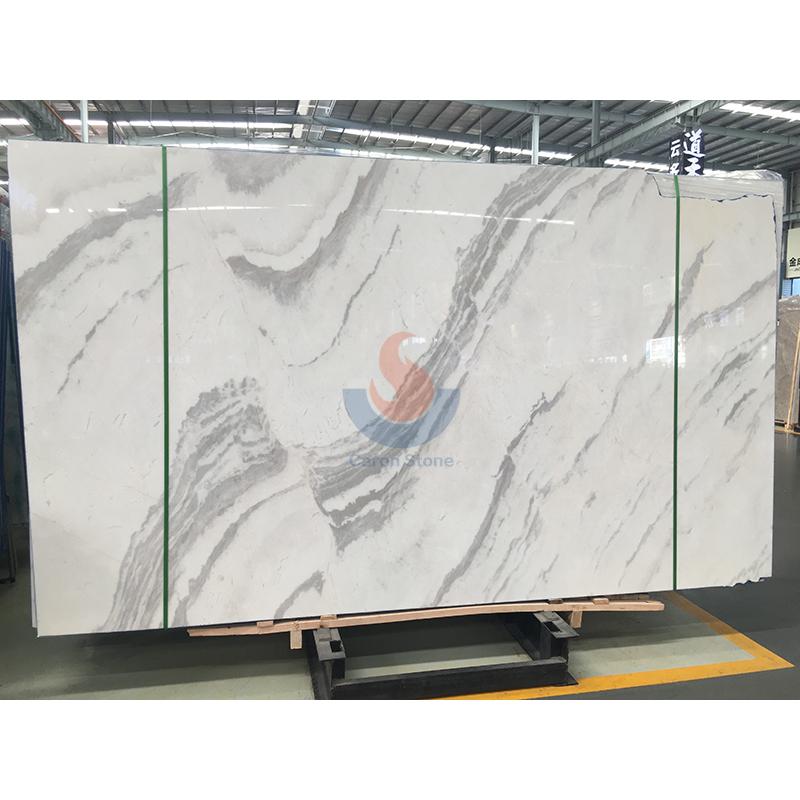When we walk into a gorgeously decorated hall or stroll through a high-end shopping mall, the brilliance of marble always attracts the eye, as if it is not only a decorative material, but also a work of art of light and shadow. Marble is well-known for its unusual light reflecting qualities since it is a natural stone. It not only gives the space a noble and elegant temperament, but also affects our visual experience. Have you ever pondered why in a marble-paved area we feel our eyes are bathed in a sort of soothing light and why in some circumstances marble makes us feel glaring or even uncomfortable? This is exactly the light reflection properties of marble at work. This article will take you to explore the light reflection properties of marble and how it affects our visual comfort.

Panda White Stairs Case
Analysis of the light reflection properties of marble
1. Marble surface gloss and reflection angle
The surface gloss of marble often determines its light reflection properties. The polished marble surface reflects a great lot of light and is as smooth as a mirror. This mirror reflection property makes the light reflect at a specific angle, forming a sparkling effect in our eyes. Still, this great gloss is not always advantageous. An extremely smooth surface will generate glare in some settings with powerful light sources or more direct light, therefore creating visual discomfort and even influencing daily tasks.
In contrast, matte marble has a special surface treatment that reduces direct light reflection and increases the diffuse reflection effect of light. This diffuse reflection helps light to be equally distributed in all directions, therefore enhancing eye comfort and producing a pleasant, non-glaring environment. Therefore, when designing a space where visual comfort needs to be considered, matte marble is usually a more ideal choice.
2. Marble color and light reflection effect
The color of marble also has a significant effect on its light reflection properties. Light-colored marble (such as white or beige) reflects more light generally; dark-colored marble (such as black or dark gray) absorbs more light and reflects less. In a bright atmosphere, this variation in light reflection capabilities makes light-colored marble more likely to seem brilliant and transparent; black marble seems peaceful and restrained.
However, in some cases, excessively reflected light may cause visual discomfort. Imagine that when sunlight shines through a huge floor-to-ceiling window onto a white marble floor, the strong reflection of the floor may be dazzling, and people may even need to squint to walk. Conversely, dark marble may efficiently lower the frequency of this condition, hence it is usually given top priority in places where control of light reflection is necessary.
3. Marble texture and light differsion
The natural texture of marble is also an important factor affecting the light reflection effect. Marble is a naturally occurring stone, hence its surface texture is usually not totally flat. The regular reflection of light can be broken by this irregular surface structure, therefore dispersing the light in several directions. It is this texture characteristic that allows marble to present rich light and shadow changes under sunlight or artificial light, enhancing the layering and three-dimensional sense of space.
This light scattering effect has an important impact on visual comfort. Marble surface roughness can efficiently lower intense light reflection and glare, therefore enhancing eye comfort when compared to flat, unpatterned surfaces. This is why in some space designs that focus on visual comfort, the natural texture of marble will be deliberately retained or even enlarged to achieve the best optical effect.
Marble application in architectural design for aesthetic comfort
1. Luxury hotels and reception halls
Marble is often extensively used in luxury hotels’ lobby or reception hall to create a noble and sophisticated environment. In order to improve visual comfort, designers usually choose marble with moderate gloss and soft color, and combine the layout of natural light and artificial light sources to avoid excessive light reflection causing visual distress to guests. In addition, the natural texture of marble is cleverly used to create a spatial effect of interweaving light and shadow, so that people can feel visual pleasure, tranquility and relaxation when they are in it.
2. Shopping centers with high ends
Marble is often utilized for floor, wall and even ceiling décor in high-end shopping complexes and malls. In order to ensure the comfort of customers during shopping, designers will choose matte marble or dark marble with low reflectivity in areas with high light intensity to reduce glare. Simultaneously, the natural texture of marble helps the mall’s whole space to seem more colorful in light and shadow effects, thereby enhancing the shopping enjoyment.
3. Conference rooms and offices
Visual comfort is particularly important in spaces such as office buildings and conference rooms where eyes need to be used for a long time. As a decorative material, the light reflection characteristics of marble must be closely integrated with the lighting design of the space. Usually, designers in these locations will select low gloss marble with soothing colors and match it with suitable lighting to make sure the user’s eyes won’t be burdened. In addition, the application of marble can also enhance the sense of luxury and professional atmosphere of the space and enhance overall work efficiency.

Popular Beautiful Marble Flooring Price Sea Marble
Marble is not only a symbol of visual enjoyment, but also a representative of optical art. By understanding and applying the light reflection characteristics of marble, designers can cleverly improve the visual comfort of the building space and bring users a more pleasant visual experience. Marble offers unique qualities in many contexts, whether they be gentle diffuse reflections of matte stone or high-gloss mirror reflection. Through reasonable selection and application, it can not only show its aesthetic value, but also meet the functional requirements of the building space. Marble will remain a material that blends beauty and use in next architectural design to produce a more pleasant living and working environment for us.





